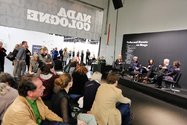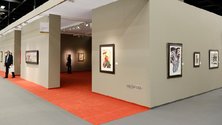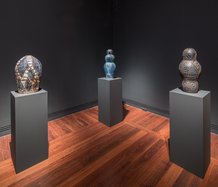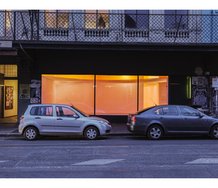Carmen Ansaldo – 1 May, 2013
Perhaps the newest and most noteworthy trend demonstrated was the new wave of ‘ironic' collections that intentionally set out to make fun of collectors and the process of collecting itself. This was the major discourse imbedded in the works exhibited from the Julia Stoschek Collection. These works critiqued the culture of the commercial art gallery, the modernist white box, and the cultural status granted to collectors through the process of acquiring notable works.
Cologne
International Art Fair
The 47th Art Cologne
18 April - 22 April 2013
Before I attempt to update EyeContact readers on this year’s installment of ART COLOGNE, I must confess that this is the first time I have reviewed a commercial art fair. Without the motivation of an overarching theme or conceptual direction, I found it difficult to assess its success as I am unsure how to determine whether a commercial art fair has achieved its goals (or not).
If we look to monetary intake, ART COLOGNE’s final figure is still being counted. If we look at punters through the door during the five days, 2013 maintains the fair’s previous average of around 60,000. Personally, I was interested in what contemporary art was currently being bought. It became apparent throughout the weekend that those who still have the cash to buy up art at this point of the global financial crisis seem to have the worst taste.
To update those who are unfamiliar - ART COLOGNE is the largest art fair in Germany and the oldest in the world (debuting in 1967 as the Kölner Kunstmarkt). Its status as one of the largest art fairs in the world (competing with Basel, Miami, London etc.) has been compromised during the last few decades as collectors grew tired of its chops and changes (locations, dates, etc.) and headed either internationally (for less sales tax on the big names), or to Berlin (for a more edgy and substantially cheaper market).
Although ART COLOGNE regards itself as an international art fair, the term should be used loosely as it always dwindles at around 20 countries represented (almost all European). This year the fair boasts representation from 25, but I still find this remarkably underwhelming considering around 200 galleries are present in total. The complete dominance of German art is both logical and historical, but this dominance does create a homogeneous feel to the works on display, a sense that slowly wore off as tedious and unremarkable as I weaved through the exhibition hall (i.e. a ‘Richter in every room’ situation). This could perhaps be alleviated with more commissioned works (as the only one I saw was the Katharina Grosse sculpture at the front door).
I’m sorry to report that no galleries from New Zealand were to be found this year (despite being represented by Michael Lett in 2012) and Australia had sole representation through the Melbourne Gallery, Neon Parc. Neon Parc was invited as part of the New Art Dealers Alliance (NADA) who set up shop for the second year at ART COLOGNE. The NADA info booth stated that the aim of the project was to foster connections between European and US collectors and galleries. The USA, being the country with the second highest representation of galleries (this year as in most years), to me did not appear to be lacking in ties with the European market. Regardless, NADA provided a diversity of emerging galleries, new artists and contemporary mediums which was a welcome juxtaposition to the infinitely replicable modernist paintings of the traditional floor.
Perhaps the newest and most noteworthy trend demonstrated was the new wave of ‘ironic’ collections that intentionally set out to make fun of collectors and the process of collecting itself. This was the major discourse imbedded in the works exhibited from the Julia Stoschek Collection under the title ‘The Museum Is Burning‘ which included artists Monica Bonvicini, Mark Leckey, Klara Lidén, Helen Marten, Bruce Nauman, Elizabeth Price, and Clemens von Wedemeyer. These works critiqued the culture of the commercial art gallery, the modernist white box, and the cultural status granted to collectors through the process of acquiring notable works.
Art fairs can be fun excursions from reality due to their trends, their gossip, their flagrant demonstrations of wealth and their fashion (but never their food). Due to the overwhelming Euro-centricity of galleries represented, the obvious fact that 2013 is shaping up to be a boringly safe and conservative year in the art market, and let’s face it, the ‘Germanness’ of the whole production, ART COLOGNE fell short on all these fronts.
Carmen Ansaldo
Recent Comments
Simon Cuming
While indeed there was no NZ gallery representation, Luis Campaña was showing NZ artist Andrew Beck.




 Two Rooms presents a program of residencies and projects
Two Rooms presents a program of residencies and projects Advertising in this column
Advertising in this column



This Discussion has 1 comment.
Comment
Simon Cuming, 1:42 p.m. 3 May, 2013 #
While indeed there was no NZ gallery representation, Luis Campaña was showing NZ artist Andrew Beck.
Participate
Register to Participate.
Sign in
Sign in to an existing account.